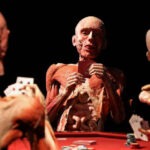
WAWADIA Update #20 /// The Kaminoff-Matthews Interview: Full Transcript
November 20, 2014
WAWADIA: Answering Some Early Objections (draft excerpt)
November 24, 2014
(A post in support of the #WAWADIA IGG campaign, which finishes up on December 1. Please support if you are so moved.)
____
T he injury stories alone have provided all the motivation I need for taking on this stupidly ambitious job.
Like:
Somebody is encouraged to “lengthen” their hamstrings through passive stretching. They are told that this will cure their lower back pain.
Somebody is taught tripod handstand without the disclaimer that any weight placed on the cervical spine is discouraged by many medical professionals.
On the general advice of their practice culture and colleagues, somebody holds plow pose for yin-lengths of time to soothe their neck pain.
Somebody’s told that their shoulder pain is karmic, related to some past misdeed, and that it’s good that it’s “coming out now” rather than causing a crappier birth next time around.
Somebody’s told that practicing the same 90-minute sequence six days per week can’t lead to repetitive stress injuries, because the sequence itself is “therapeutic” – and you can’t overdo therapy, right?
Somebody latches onto a studio’s “unlimited” introductory month and isn’t discouraged from coming to three elite-level classes per day, or from signing up for the studio’s popular green juice cleanse, even though she looks very slender and somewhat wan.
Somebody is shown how to do a posture that demands torsional stress on the knee. They injure their knee attempting it, and then are told they can avoid injury in the future by working on their “ego”.
A teacher asks whether there are any students in the class who’d rather not be adjusted. Somebody with PTSD puts up their hand. In front of everyone, the teacher asks them what their problem is.
Somebody’s encouraged to keep practicing while injured, to “keep the prana moving”, but isn’t given any corrective or therapeutic movements, because the instructors are certified in yogacheering, but not physiotherapy.
Somebody is told to stop crosstraining because it will stiffen them up and because “asanas are all you need to be healthy.”
Somebody has their hamstring attachment torn by an instructor who decides it’s a good idea to lay their full body weight across the student’s back while they are in Supta Kurmasana, because, you know, ‘openness’.
Oh, and then somebody gets slapped in the head by an abusive instructor. It goes on and on.
In each of the above, you might as well replace the word “somebody” with “many people.” Because I’m pretty sure the stories I’m collecting aren’t isolated. So yeah: I have a lot of motivation. But every once in a while I come across a piece of yoga culture that gives me that little extra kick.
C onsider this anonymous, borderline-abusive post from the Ashtanga Picture Project on Friday, entitled “The Yoga Is Not The Problem… You Are.” On one hand, it chapped my ass hard on behalf of those who tell the stories above, plus myself, plus countless others who injure themselves or are injured by teachers in the strange shadow of yoga’s therapeutic marketing. On the other hand, seeing the megalomaniac victim-blaming hubris of modern postural yoga parade in full monty makes my job a lot easier, if a lot less pleasant.
I’ve laid into the Ashtanga Picture Project before, back when its Admin suggested that attaining “impossible” postures is a simple matter of believing in yourself and working hard, and ergo has nothing to do with particular physical traits, dubious functional movement goals, and lots of leisure time. I really don’t mean to hound this blog, because its heart is probably in the right place and all that, but when this particular post gets over two thousand Faceblot hits… come on. It’s a drum corps march of every tone-deaf, dangerous, pious, evading-serious-issues, “you’re on your own” platitude you’ll ever hear in Yogaland. I won’t quote much of it, because this is how it starts:
Whatever pain you are feeling from yoga, it is caused by you. It is caused by your attitude. It is caused by your actions. It is caused by your interpretation of the shape. It is caused by your thoughts.
In other words: yoga practice happens in a psychic bubble of me-ness that attempts physical shapes and gets injured in the process because of … character flaws? Also – practice has no interpersonal context. In this slice of Admin’s world, there are no teachers, techniques or instructions, and no communal goals. No people advising other people on what to do or how. No differing levels of training in biomechanics. There is no learning from each other, or from groups, or from temple friezes in Karnataka, or from Lilias on PBS, or Richard Hittleman’s 70s classic, or Kino’s YouTube channel. In short, Admin seems to claim that yoga operates pristinely, outside of culture.
It’s not true. People learn asanas from other people, just like babies learn any type of movement at all: through imitation, instruction, hands-on manipulation. The most antisocial yogi in the loneliest cabin in the most remote forest is practicing under the influence of a culture. Today, in a fractal-explosion of the photoplates of Light on Yoga, some people even learn about asana through the yoga-selfies of people they’ve never met. That’s what APP is all about, no? APP is fostering a culture of yoga, while saying, in this post at least: there is no culture. The Yoga and Body Image Coalition is also fostering culture. If you click through you’ll see that it’s just a little bit different.
W here could this “you are the problem” argument be coming from? I reached out to the APP Admin to try to understand this better, but they didn’t respond, so I’ll take a crack at a few possible answers.
Superficially, APP’s post tops off a messy layer-cake of recent Ashtanga aversion-and-attachment manifestoes. In layer one, Annina Luzie Schmid baked up a searing defection notice, which was quickly smeared with enough commentary-custard to be reposted by Yogadork. Layer two popped out of the springform pan of Jessie Horness, whose unfazed devotion to practice seems to mean that she doesn’t care enough about any of the cultural issues that Annina raised to actually address them. Next, APP drizzled a coulis of refutations, and then added the post in question as icing. So in a way, it’s all just an old-fashioned yogasphere confection: bitter, tart and sweet.
(Of course then – I have to mention – Zoë Ward took that cake and smooshed it in the internet’s face with this eerie mashup of hate and love, reframing the rejection-allegiance tension down to the moment of the vritti – the no-and-yes of practice. I appreciate that this piece actually describes the deep ambivalence at the heart of the matter, rather than staking out territory.)
In a broader scope, this post is a reminder of the pervasive effects of neoliberal brain damage. It’s been twenty-five years since Dame Thatcher proclaimed to her Conservative party Conference that “there is no such thing as society. There are individual men and women.” How many of us have internalized this, surrendered to it, and perhaps think we can recast the hostility of our political zeitgeist as the backdrop of some heroic vision quest? How many of us have yogawashed the hyperindividualism of the age into the wish that transformative narcissism is a viable path? The entire culture is saying: Things are good. You’re on your own. You’ve been given the endless-growth truth about human life: don’t be ungrateful. The playing field is as level as a yoga mat. Whatever happens on it is between you and God. Whatever pain you are feeling from your culture, it is caused by you. Go on, manifest!
B ut the APP post reminds me of something else. It communicates something developmental, which unfortunately doesn’t read well in print. Admin’s thesis might be useful in a moment of one-on-one confrontational psychotherapy. But putting it into print is a kind of violence.
I grew up, as I imagine almost everybody does, in an objectivist, essentialist mood. Susan Gelman describes it well in The Essential Child. The world was filled with objects and populated by people, and it was my job to go out and learn about them and decide what they were – not to me, but in themselves. In developmental psychology, it’s a mood that pervades ages four to seven, a period of almost continual extroversion that seeks to name and hopefully control the world. It opens the door a few years later to the Hardy Boys, or Nancy Drew, who are never paralyzed by the question “Who am I?” The adult version of this mood is nourished by Sherlock Holmes. We love Cumberbatch in that role because it feels like he’s about six years old, without a shred of self-consciousness. (How he becomes a sex symbol through that is a whole other story.)
While I was trying to become an adult, I had two insane gurus. They smashed whatever was left of this objectivist mood with their one-trick pony wrath. “Reality is subjective!” yelled one. “It’s all in your mind!” bellowed the other. For a while, I cruised through an almost unbearably lighter world. It was indeed freeing to flip the cognitive error of childhood: to consider my own interiority as the common denominator of all experience, perhaps even the source of it. What couldn’t I change? The world wasn’t the problem. I was. I could start with the man in the mirror, to quote Michael Jackson’s impossible pledge — he who looked into so many mirrors and probably couldn’t see a stable self to start with at all.
I get the sense that “It’s all in your mind” is the vinyasa that the APP Admin is flowing through right now. In fact, in one of their answers to complaints about the post, they write:
How is saying that you are responsible for your life shaming? To me, it is freeing.
To which I say: yes, it can be freeing. For a while. Until you see that neither position is really true, let alone sustainable. Reality isn’t objective, and it isn’t subjective. If we can find reality at all, it’ll be somewhere in the middle, where we realize with a shock first sickening and then poignant that we actually have no idea where we end and where our culture begins.
I think we soften that shock in the yoga shala, by realizing that we really don’t know where the teacher’s body ends, where the body of the fellow student ends, and where our flesh becomes ours alone, if it ever does. By realizing that while asana can feel solitary, it’s never alone, because movement connects identities by breaking them down.
This all means that it really matters how we treat each other. Because the body is culture.
____